
I was looking into the tale of Slenderman, and it led me on an interesting journey into the tale of the Pied Piper of Hamelin. I thought I’d share what I’d learned, for anyone who is interested.

Also a side note that my images were found in common license areas, though I am going to do a triple-check later to be sure.


Everyone lives different lives. Slenderman might be a famous phenomenon, but that doesn’t mean everyone knows about him. For those that don’t know what I’m talking about:
.
Slenderman is a malevolent poltergeist. He has multiple tentacle-like arms, and is always in a suit and tie. However, he does not have a face, or any identifying features on his head. He is called “Slenderman” because he is extremely thin, and unnaturally tall.
.
There are many variations of the Slenderman legend. In most versions (including the person that came up with the character), he kidnaps children and takes them into the woods to kill them. Some say he grabs them while they are sleeping. Others say he stalks and terrorizes his victims for days, until they are driven so insane, they do whatever he wants to have an end to their torment.
.
Some versions of the legend say he befriends the children, and then lures them into the woods to kill them.

This was a creepy pasta tale. The author was inspired by HP Lovecraft, and wanted to create a horror tale with an evil poltergeist with motives that no one understands.

When I read into the Slenderman Lore, I kept thinking of the Pied Piper from Hamelin. The similarities really struck me.
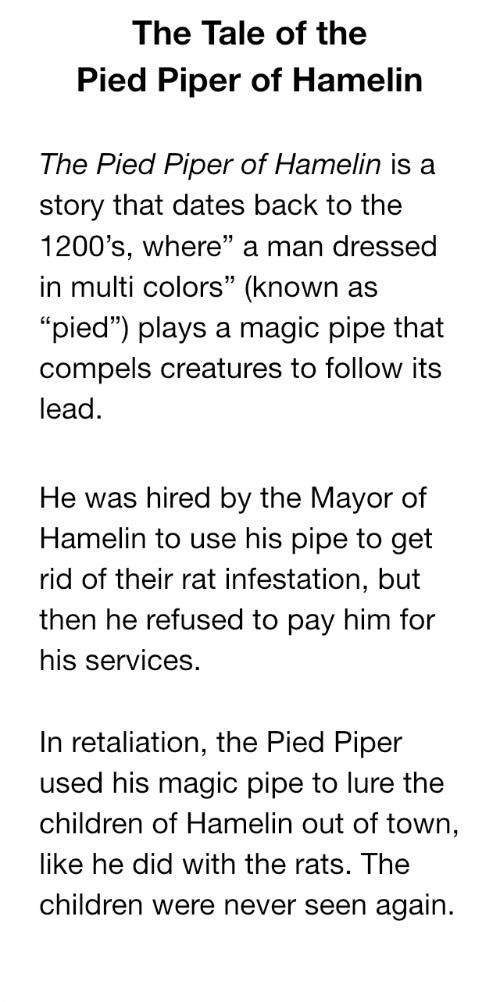
There’s the short version for anyone who needs it!

In 1284, while the town of Hamelin was suffering from a rat infestation, a piper dressed in multicolored (“pied”) clothing appeared, claiming to be a rat-catcher. He promised the mayor a solution to their problem with the rats. The mayor, in turn, promised to pay him for the removal of the rats (according to some versions of the story, the promised sum was 1,000 guilders).
.
The piper accepted and played his pipe to lure the rats into the Weser River, where they all drowned. Despite the piper’s success, the mayor reneged on his promise and refused to pay him the full sum (reputedly reduced to a sum of 50 guilders) even going so far as to blame the piper for bringing the rats himself in an extortion attempt.
.
Enraged, the piper stormed out of the town, vowing to return later to take revenge. On Saint John and Paul’s day, while the adults were in church, the piper returned dressed in green like a hunter and playing his pipe. In so doing, he attracted the town’s children. One hundred and thirty children followed him out of town and into a cave and were never seen again.
.
Depending on the version, at most three children remained behind: one was lame and could not follow quickly enough, the second was deaf and therefore could not hear the music, and the last was blind and therefore unable to see where he was going. These three informed the villagers of what had happened when they came out from church.
.
Other versions relate that the Pied Piper led the children to the top of Koppelberg Hill, where he took them to a beautiful land, or a place called Koppenberg Mountain, or Transylvania, or that he made them walk into the Weser as he did with the rats, and they all drowned.
.
Some versions state that the Piper returned the children after payment, or that he returned the children after the villagers paid several times the original amount of gold.
.
The Hamelin street named Bungelosenstrasse (“street without drums”) is believed to be the last place that the children were seen. Ever since, music or dancing is not allowed on this street.
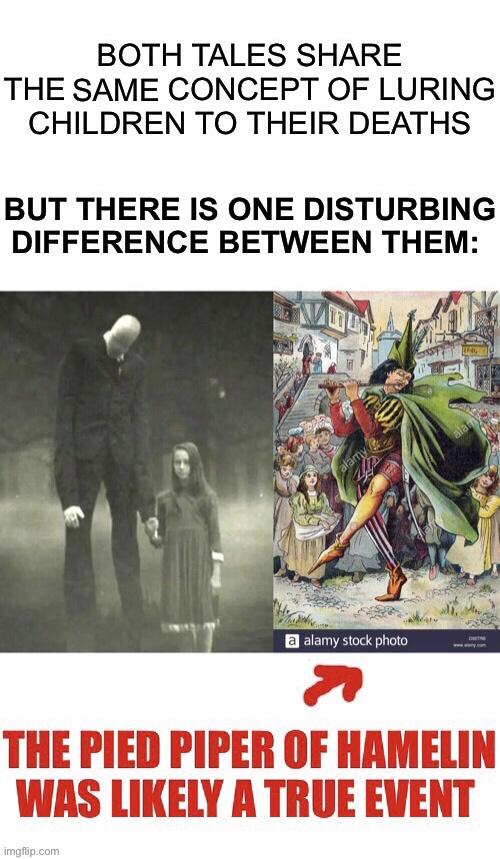
I was both intrigued and creeped out when I learned this.



It’s not believed that the Pied Piper lived there, but there is an inscription that mentions him – which is where it got its name.

I had no idea what a façade was until I was doing research into the Pied Piper of Hamlin. I’m also not sure exactly where the inscription was found, but I think it was in the general location of the arrow.

There is a plaque on the building that offered an English translation, but I also found a Wikipedia article that had both the original inscription and the translation side by side.

I could not, for the life of me, find an image of the actual record, but MANY sources say it exists.



These are all medieval scriptures that mention the incident in Hamelin, and this is only a portion of them. There were quite a few sources, according to the cited sources in the Wikipedia article (never trust Wikipedia, trust the sources they cite instead)


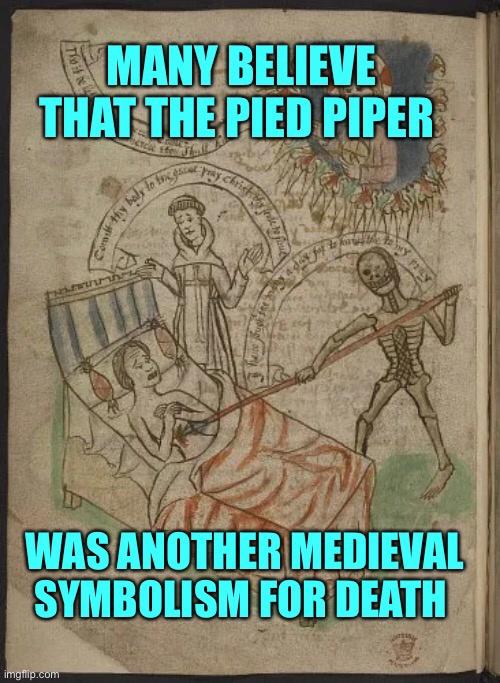
A common theory is that the Pied Piper is a symbol of death. It was not uncommon for children to die in the Middle Ages, due to religious violence, lack of understanding of hygienic practices, and lack of vaccines.
.
There was perhaps a natural disaster that killed the children. Possibly even a plague that wiped them out in one day.
.
Medieval tales often had fantastical symbolisms for death in one way or another, because the possibility of dying was a frequent part of their daily lives.
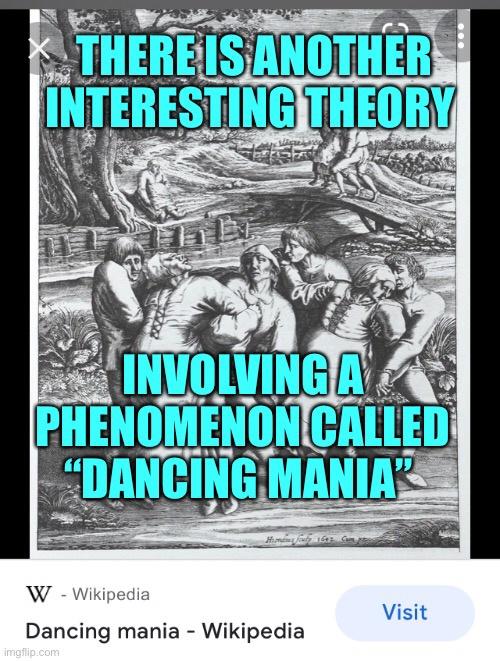
Medieval ages were the golden era for mass hysteria. This manifested in many ways, including an unusual one known as “dancing mania.”
.
“Dancing mania” is when a person is compelled to dance until they exhaust themselves. There have been quite a few historical records of such occurrences. Some of them even died, or had permanent tremors as a result of the phenomenon.
.
Some theorize that the children were overcome by dancing mania, and they wandered away, dancing themselves to death.
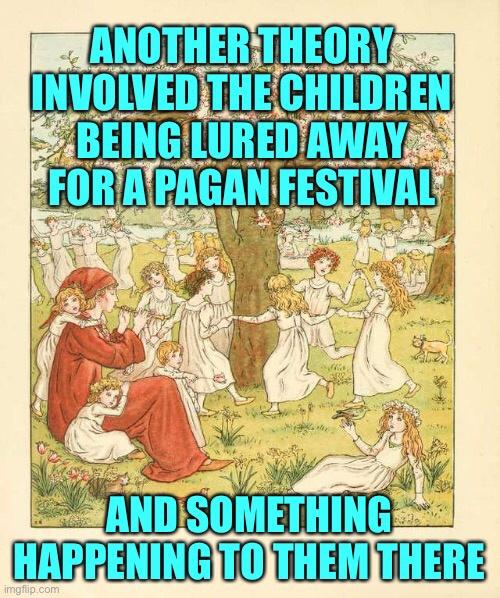
I read many articles that mention the theory of the children being taken to a Midsommer festival. While they were there, something happened to them – natural disaster, sinkhole, etc… and they never came back.

BBC did an article that suggested the Pied Piper was a recruiter, or relocater. This person encouraged a large migration of German youth into other parts of Europe, due to economic troubles.
.
Sometimes recruiters, or “relocaters” would try to recruit young people to move to other areas for expansion. They were noted as wearing a special outfit that included a unique cap, as is depicted in this image. This could explain the mentioning of a “pied” individual.
.
There is also compelling evidence to support this theory. Family names that were common in Hamelin show up with “surprising frequency” in the areas of Uckermark and Prignitz (near the area of Berlin).
.
BBC Article: https://www.bbc.com/travel/article/20200902-the-grim-truth-behind-the-pied-piper
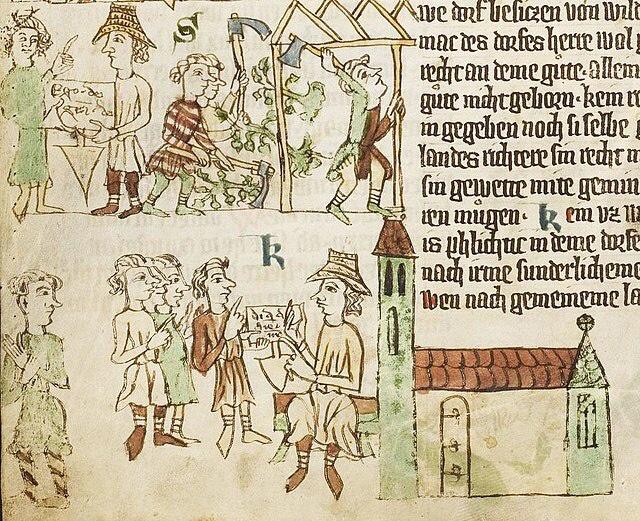
Here’s the previous image not covered up by captions. You can see the hat better.

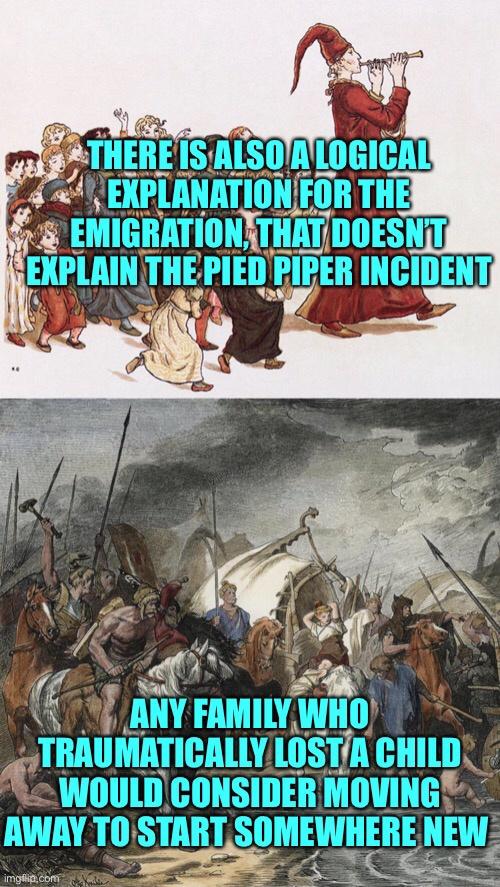
Now, I need to add that this is MY personal outlook on that theory. There might be evidence to refute it.
.
But I wasn’t terribly convinced by the emigration theory. Whatever happened to the 130 children was traumatic enough to be mentioned in records entire centuries after the incident. It was even engraved in the top of a building.
.
In the immediate aftermath, any grieving family would consider starting over somewhere else – away from all of the memories of the traumatic incident.
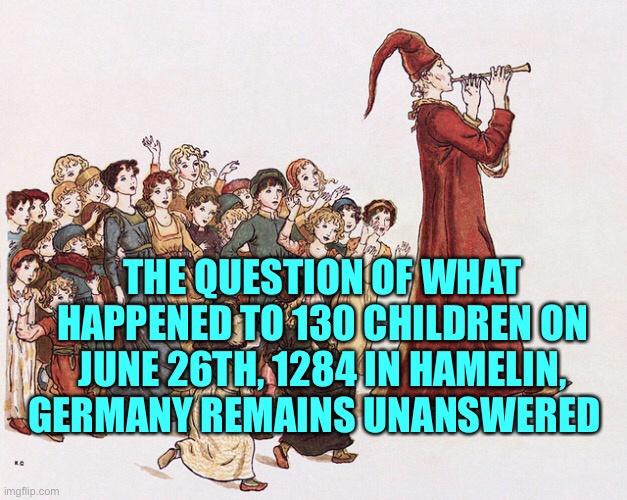
I am sorry for reusing this image so much, but it was the best one that depicted him leading the children away.

Whatever happened to 130 children on June 26th, 1284 in the village of Hamelin might be a mystery that is never solved.
There’s a reason my text layout includes the little dots and extra paragraph breaks. If you’re interested in the reason behind this, I explained it here.